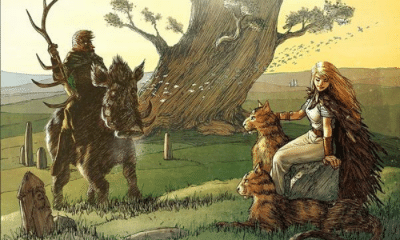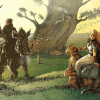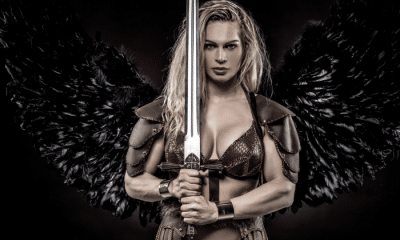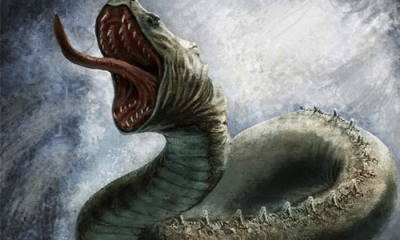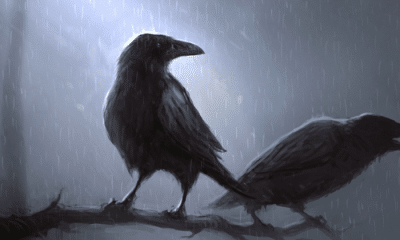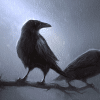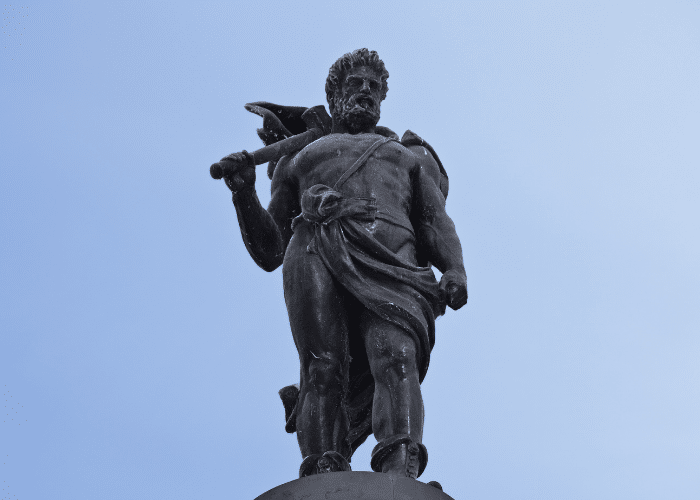
Norse
Who Was the Norse God Thor?
Who Was the Norse God Thor?
Keep reading to find out why Thor was so important in the ancient world and why he continues to be popular today!
In the ancient world and today, Thor has always been one of the most popular and recognizable figures in mythology.
As a sky god, Thor is part of a long tradition of deities who commanded thunder and brought on storms. This also made him an important fertility god who brought the water necessary to make plants grow.
While Thor was known for his power over thunder and lightning, there was more to the god than just this, however. He also showed himself to be a clever deity who could use his wits as well as weapons.
Thor used a combination of cleverness, physical strength, and even occasional humor in many stories. He traveled across realms, fought monsters, and killed giants with his legendary hammer.
As such an important god, Thor lived on in a number of ways after the Viking Age. From place names to characters in popular culture, Thor remains an influential figure from mythology.
Thor Through History
Thor was one of the most popular Norse gods, but his appeal was not limited to the Viking Age.
Although scholars once thought that Thor was an indigenous god of Scandinavia, similarities between the Norse god and others make it seem almost certain that he came from a Proto-Indo-European deity. Similar thunder gods can be found as far away as India, where the Hindu god Indra even shares his red hair.
Thor was a god of thunder and storms, but like many others he also picked up aspects of a fertility and prosperity deity. Because rain fertilizes the soil and makes plants grow, many religions recognize otherwise destructive sky gods as having a hand in giving life.
In Northern Europe, Thor was recorded long before the height of Norse culture. The Romans noted a Germanic god who is almost certainly the direct ancestor of the Viking thunder god.
The Romans typically assigned the names of their own gods to those they encountered elsewhere, believing that other religions worshiped their own pantheon under different names and guises. While Odin was the father and king of the Aesir, the Romans associated Thor with Jupiter.
The Roman military leaders who first encountered the people of Northern Europe immediately saw the similarities between their own thunder-wielding sky god and Thor.
They also called him by the name Hercules. While Jupiter was an older, wiser figure, Thor was noted for the strength and adventuring spirit that defined the Greco-Roman hero.
In the centuries following the fall of Rome, the Germanic people had not yet fully developed their own system of writing. Still, Thor was sometimes recorded by Christian missionaries who began to preach to the people of Germany and Britain.
An account of the works of Saint Boniface in the 8th century claims that he cut down a tree dedicated to a pagan god in the Hesse region of Germany. The tree was called Donar’s Oak, Donar being the Old German name for Thor.
A century later, Thunaer and Uoden were named among the pagan Saxon gods to be renounced as demons in Christian baptism. His name even survived in Kent, where an 11th century Christian legend recounts Thunor as a villain.
During the Viking Age, evidence suggests that Thor was even more widely-revered than the chief of the gods, Odin. While Odin was an often mystical and bewildering figure, Thor personified the strength that man men of the age aspired to.
Symbols connected to Thor are often found throughout Scandinavia, Germany, and Britain. Archaeologists believe that there were protective charms and lent the wearer the god’s renowned strength.
Around this time, Thor’s name also came to be used widely for both people and places throughout Scandinavia.
Many names that are known from the period pay homage to Thor. Names like Torvald (Þólvaldr “Thor’s Ruler) and Haldor (Hallþórr “Rock of Thor”) remain in use in Nordic countries to this day.
Many places were also named in Thor’s honor, both in Scandinavia and in areas settled by the Norse people. In Essex, for example, the village of Thundersley was originally called Þunrez leah, or “Thor’s meadow.”
In written records, archaeological finds, and surviving language, Thor is so well-attributed that some historians believe he may have once been the primary god of the pantheon. The god of thunder in later years was rewritten as the son of Odin, but in early Germanic religion Thor may have ruled over the other gods.
The Thunder God’s Family
Unlike the mythologies of places like Greece or Egypt, the Norse did not put a great deal of emphasis on the family relationships between their gods. Many, for example, do not have any surviving legends that name their parents or spouses.
Thor is an exception to this, however. He is a central member of Norse mythology’s most famous family.
By the time the Norse legends were written down in the 13th century, Thor was universally known as a son of Odin, the chief god of the Aesir pantheon. In many myths he appeared at his father’s side as they fought, feasted, or travelled through the Nine Worlds.
Although Thor was his most famous son, his mother was not Odin’s wife Frigg. Often, his mother is not named but when she is she is called Jord and is a jötunn, or giantess.
Because he was Odin’s son, Thor was also the brother of many of the other gods in the Norse pantheon. Baldr, Víðarr, and Váli are usually named as sons of Odin, but some texts also include Hóð, Heimdall, or Týr.
Thor’s wife was named Sif and she was known for her long hair that was replaced with real gold after Loki stole it in a prank. Sif is often interpreted as a harvest goddess, making their marriage an example of a frequently-seen connection between a sky god and an earth goddess.
Sif and Thor had at least one child together, a daughter called Thrud (þrúðr). Sadly, many of Thrud’s myths seem to have been lost.
In one story, for example, a dwarf named Alviss claims that he is engaged to be married to Thor’s daughter. In another, a giant called Hrungnir is called “the thief of Thrud,” but the story of this abduction is lost.
Thrud is also the name of one of the valkyries, leading many historians to believe they may have been the same character.
Thor also had a giantess lover called Járnsaxa, with whom he had at least one child, a son called Magni. It is unclear whether she or Sif was the mother of his other son, Móði.
Thor’s three children represent his three defining features. Thrud’s name means “strength,” Magni translates as “mighty,” and Móði is the Old Norse word for “wrath.”
Such direct personifications are rare in Norse mythology, which may be a sign that these minor deities were holdovers from a more ancient prototype.
Finally, Thor had famous stepsons as well. The god Ullr was called his stepson, Sif’s son, by some poets and others said that Járnsaxa was one of the nine sisters who collectively were mothers of Heimdall.
The Adventures of Thor
Many of the Norse gods are known from only a handful of stories. For most, there are only one or two surviving poems that mention their deeds or attributes.
Thor, however, is the star of many Norse tales.
One of the most popular stories was that of Thor’s fishing trip with a giant named Hymir.
Thor disguised himself as a child and offered to help the giant row his fishing boat out to sea. While Hymir was not convinced that such a small child would be of much use, he agreed to take the boy along.
Thor rowed further and further from the shore until they were in deeper water than the small fishing boat had ever been in before. Hymir warned him not to go any farther because they would soon enter waters that were the home of many monsters, including the world serpent Jörmungandr.
Thor ignored the nervous giant’s pleas, however, and happily threw his fishing line out into the ocean water. Soon, he felt a bite on the line and began to pull with all his incredible strength.
He had, in fact, hooked the world serpent. He managed to hit it once over the head with his hammer before Hymir, afraid of the great serpent, cut the line and allowed the creature to escape.
Thor was known for his strength and in many stories was referred to as a slayer of giants. Most often he is able to use his strength, or the threat of it, to overcome his problems.
In some cases, however, strength was not enough. Some stories showcased Thor’s wit more than his raw power.
For example, when the dwarf Alviss tried to claim Thor’s daughter as his bride, the god could not simply fight him. Instead, he said that Alviss had to prove his worth through a test of riddles.
Thor purposefully dragged the test out, prolonging it until the sun rose. Because dwarves turned to stone when exposed to the light of the sun, Alviss was petrified and Thor’s daughter was saved.
Once in a while, Thor even had to humiliate himself to defeat his enemies.
In one story, Thor discovered that his hammer, Mjölnir, had been stolen while he was sleeping. After much searching, he learned that a giant named Drymr (Thrym) had taken it and demanded to marry Freyja in exchange for its return.
The gods, of course, would not send one of their loveliest goddesses to be a giant’s wife against her will, so they met to find a solution. Heimdall suggested that Thor disguise himself as Freyja to steal Mjölnir back.
Thor was against the idea, but Loki decided to accompany him as a maid. The two went to Thrym’s palace disguised as women with heavy veils to hide their bearded faces.
Thrym grew suspicious when “Freyja” ate several whole animals and drained three casks of mead at a feast, but Loki told him that she had been so nervous that she had not eaten for several days. When the giant saw Thor’s intense eyes, Loki again explained it away by saying that Freyja had also not slept because of her nerves.
Finally, Thrym ordered the hammer to be brought out to sanctify the bride so the wedding could be complete. As soon as it was in reach, Thor grabbed Mjölnir and killed all the giants in attendance, including Thrym.
Thor was not always the victor, however.
Has Thor never come where he has found anything so strong and mighty that it has been superior to him either in strength or in the black art? … Few men, I know, are able to tell thereof, but still he has often been in difficult straits. But though there have been things so mighty and strong that Thor has not been able to gain the victory, they are such as ought not to be spoken of; for there are many proofs which all must accept that Thor is the mightiest.
-Snorri Sturluson, The Prose Edda (trans Anderson)
The most famous story of Thor’s defeat was against a giant king called Útgarða-Loki, who assigned him a series of challenges that he assumed would be easy.
The giant first challenged Thor to a footrace against one of his servants, which he lost badly. Then, he asked Thor to lift up his pet cat, but the god could barely get one paw off the ground.
In a drinking contest, Thor was unable to empty even half of his horn. He was finally tasked with wrestling the king’s nurse, a shriveled old woman, but was pinned in a matter of moments.
Thor was humiliated, but Útgarða-Loki commended him for doing much better than another else could have managed.
The servant he raced was actually Thought, which could move faster than any living thing. The cat was the serpent Jörmungandr in disguise, so lifting even one paw was a feat of strength.
Thor had been unable to drain his drinking horn because the end had been connected to the sea, but he drank enough to lower the water by several feet. And the old woman he wrestled had been Old Age itself, which no man or god would ever be able to defeat.
This story showed that Thor could be defeated, but his strength was still far beyond that of any man or even the other gods. He fought well against things that could never be beaten.
Against most foes, however, Thor would be successful. When Loki became an enemy of the gods, Thor was the only one he still deferred to at all because he knew he was no match for the thunder god’s anger.
Strong Weapons
Thor was able to fight against such powerful foes, in part, because he had remarkable weapons and armor. His remarkable strength served him well, but his magical items made him nearly unbeatable.
The most famous of Thor’s attributes was his war-hammer, Mjölnir.
The hammer had been one of the many gifts crafted by the dwarves when Loki replaced Sif’s hair with gold. Because Thor was so angry at Loki for stealing Sif’s beautiful blonde hair, the trickster was eager to win back his favor.
Although its handle was slightly too short for it to be perfectly balanced, Mjölnir was still a remarkable weapon.
Thor could hit any surface with all his might and the hammer would not break. Every shot would strike at full power and with perfect aim.
This was true when Mjölnir was thrown, as well. When thrown, it would also automatically fly to Thor’s hand so he would never be unarmed for more than a moment.
The hammer seems to have had significance in Thor’s role as the god of the sky. It could throw lightening bolts in some stories and Scandinavian folklore claimed that the sound of Thor’s hammer striking his enemies created thunder.
Mjölnir may have also had significance as a symbol of the god.
Archaeologists working in Scandinavia often find pendants or amulets in the shape of Thor’s hammer. These, along with inscriptions and other images, make it one of the most frequently used symbols in Viking Age art.
It is often believed that these pendants served as protective charms. They may have been believed to give the wearer a portion of the god’s legendary strength.
There is also some evidence that Mjölnir amulets were used as fertility charms, as well.
Thor’s marriage to Sif and connection to rain made him a fertility figure. The practice of burying small hammer-shaped charms with the first seeds sown in the spring continued in some rural regions long after the people there converted to Christianity.
Some scholars see traces of this belief in the story of Thor’s imitation of Freyja when the marriage is sanctified by placing the hammer in the bride’s lap. A Bronze Age carving that shows a couple standing before a larger figure holding a hammer has been taken by some to show that the symbol was used in marriage for hundreds of years.
There is also some evidence to suggest that representations of Mjölnir were worn more generally as symbols of faith and devotion, as well. A 10th century jeweler’s mold from Denmark, for example, has chambers for making both hammers and Christian crosses, indicating that they were worn in a similar way by people of the era’s two different religions.
While Mjölnir was Thor’s most iconic item, there were others associated with the god, as well. These included:
- Megingjörð – The Belt of Strength doubled the god’s already impressive power and, according to some accounts, allowed him to wield Mjölnir when no one else could.
- Járngreipr – Iron gloves allowed Thor to pick up Mjölnir. He may have needed them because of the hammer’s imperfect handle or because of the lightning it created.
- Hreggs Váfreiðar – The Hovering Chariot of Storms was pulled by two immortal goats named Tanngrisnir (Teeth-barer) and Tanngnjóstr (Teeth-grinder).
- Grídarvöl – In some legends, the giantess Grid (Gríðr) gave Thor many of his items to help him defeat other giants. One of these was her staff, which presumably gave him some magical abilities he did not otherwise possess.
All of Thor’s strength and magical items, however, would not be enough when Ragnarök came.
Thor at Ragnarök
One of the central features in Norse mythology was the belief in Ragnarök. The Norse people believed that the end of the world and the fall of the gods had been foretold in precise detail and could not be avoided.
Many of Thor’s most famous stories include foreshadowing about Ragnarök and his eventual fate.
For example, Thor is positioned as antagonistic toward Loki well before most of the other gods become hostile to the trickster. In two instances, when Loki steals Sif’s hair and when he interrupts the gods’ final feast, Thor threatens violence against Loki.
Eventually, all the gods would be positioned against Loki. Thor’s repeated distrust and dislike of Loki, however, are sometimes the first indicators of the trickster’s eventual role as the enemy during Ragnarök.
Thor is also closely linked to one of Loki’s children. More than one legend brings Thor into conflict with the serpent Jörmungandr.
One of Loki’s monstrous children, Jörmundgandr is so large that his body encircles all of Midgard. When Odin and the other gods discovered Loki and Angrboða’s vicious offspring, the serpent was cast into the sea.
It was there that Thor attempted to capture and strike down Jörmungandr for the first time. Although he was able to catch the serpent, his companion’s fear prevented him from killing it.
Jörmungandr would remain in the sea until Ragnarök began. Before the last battle, the great serpent would haul itself onto land, crushing mountains and bringing enormous tidal waves.
When the battle began, Thor would once again take on Jörmungandr. It would be one of the greatest fights of Ragnarök.
Ultimately, Thor would kill the world serpent. He would not survive the encounter, however.
During the fight, Thor would be bitten. When Jörmungandr fell, Thor would try to help Odin in his fight against Fenrir but would make it only nine steps before the serpent’s venom killed him.
Thor would be one of the many gods to die during Ragnarök, but his legacy would not end.
In addition to some of his brothers, Thor’s sons would survive the destruction. Magni and Móði would retrieve their father’s hammer from the battlefield and rejoin the other survivors to rebuilt Asgard.
An Ancient God in the Modern Era
Thor was an important god to the people of early medieval Scandinavia, but his influence continues to be felt in our own culture.
Thor’s name lives on not only in places and a handful of given names. On our calendars, the fifth day of the week is still Thursday, or Thor’s day.
Many gods have similar subtle influences on the modern world, but Thor is one of the few Norse deities who remains well-known and easily-recognized.
As such an important figure in mythology, Thor was reference often in European poetry and literature. Many 19th and early 20th century authors and scholars from Germany used pagan themes and folklore to promote a sense of national and ethnic pride.
Unfortunately, this led to ancient Germanic and Norse characters and imagery being adopted to promote cultural superiority, as well.
Germany famously used such imagery as part of its official propaganda before and during World War II. In the 21st century Thor’s hammer is sometimes used as a symbol by white supremacists throughout Europe and North America.
Some groups, however, have restored the image of Mjölnir to one of its original purposes. Some modern neopagan groups use the hammer as a symbol of their faith in the same way that medieval Norsemen did, and it is even recognized as an official religious symbol by many governments.
For most people however, Thor’s name does not bring up images of nationalism or religion. Today, more people are familiar with Thor as a source of entertainment.
In 1962, comic book editor Stan Lee, his brother Larry Lieber, and artist Jack Kirby reimagined Thor for a new audience. The Norse god became a comic book hero.
Marvel Comics reimagined The Mighty Thor, as he was called, in some ways. The red hair described in Norse writings was changed to blond and he was given a stereotypical, if historically inaccurate, winged helmet.
In many ways, however, the comic Thor remained relatively true to his ancient origins. He was an immensely strong and courageous warrior who could summon lightning and encounters, among other comic book villains, many of the same giants and monsters that he faced in legend.
Mjölnir was also included in this modern reimagining. In addition to its traditional accuracy and ability to return to Thor’s hand, the hammer also granted him the power to fly and could give anyone worthy the same strength as the god.
Loki was soon introduced into the story as Thor’s adopted brother, reflecting the Norse trickster deity’s status as a one-time friend of the Aesir gods. Eventually, other mythological figures such as Sif, Heimdall, and Surtur were written into the increasingly complex story of the comics.
Thor was also a founding member of The Avengers and has appeared in every volume of that series.
He has also appeared in many Marvel films. Since 2011, Thor has been a fixture of the Marvel Cinematic Universe.
Loki has served as a primary antagonist for many of the films in the series who, like his mythological inspiration, often has wavering allegiances. Other characters from Norse mythology and locations, such as Asgard, have also featured prominently.
Over time, the character of Thor has become more human and more comedic while being depicted in distinctly modern settings. But many elements of the character, from his incredible strength to his bravado, would be very familiar to the people of Viking Age Scandinavia.
Thor in Norse Culture and Beyond
The Norse god Thor was derived from the widespread sky god archetype of Indo-European mythology. As such, he can be compared to kingly figures like The Roman god Jupiter, Greek Zeus, and Hindu Indra.
As a god of storms, Thor was also associated with fertility. He was married to an agricultural goddess, Sif.
Like many thunder gods, Thor was known for his physical strength and quick temper. He was the most intimidating of the Norse gods, as seen in the fact that even the rebellious Loki avoided conflict with him.
Odin’s son was a popular character in Norse mythology, with many more surviving stories than most other deities of the pantheon. In his many adventures he fought giants and monsters, outwitted dwarves, and even disguised himself as a goddess to regain his stolen hammer.
This hammer, Mjölnir, was Thor’s most defining attribute. Its magical powers made it a powerful tool and its image was used as an amulet and symbol of faith by many Norse people.
Mjölnir would pass to Thor’s sons after his death in Ragnarök. Despite his amazing abilities, the thunder god would fall in battle against one of his oldest foes, the world serpent Jörmungandr.
In history, however, Thor would live on. His name has been incorporated into the names of both people and places throughout Europe and is the root of the word Thursday.
As a character, he is also popular. After appearing in Germanic folklore for many generations, modern audiences around the world recognize him in comic books and films.


